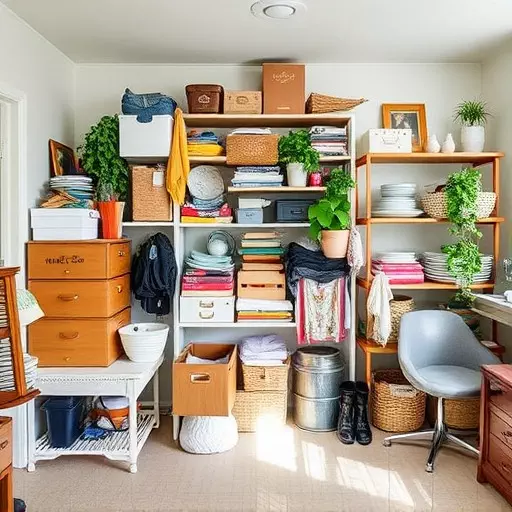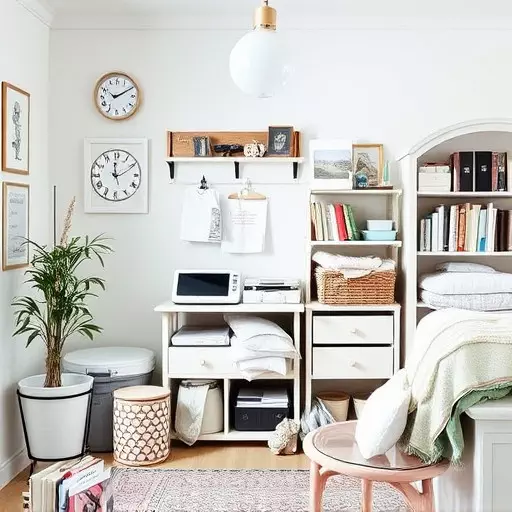TL;DR: Understanding clutter involves identifying habits like impulsive buying and lack of storage. Through self-reflection and journaling, individuals can address root causes, leading to personalized organizing systems. Implementing solutions like pull-out drawers and dedicated zones reduces stress, fosters control, and cultivates a healthier relationship with possessions. Regular decluttering and routine reviews maintain order, transforming home organization into an enduring lifestyle for a peaceful, functional living environment.
Unravel the secrets to achieving a clutter-free haven with customized organizing systems. In today’s digital age, where possessions multiply faster than we can say “hoarding,” finding order is more challenging than ever. This comprehensive guide breaks down the process into manageable steps. We’ll explore how understanding your unique clutter and personal habits leads to designing tailored systems. Learn practical strategies for implementation, from efficient storage solutions to woven into daily routines, ensuring long-term success in home organization and decluttering.
- Understanding Your Clutter: Uncovering Personal Habits and Preferences
- The Art of Customization: Creating Systems Tailored to Individual Needs
- Implementing Practical Solutions: From Storage to Daily Routines
- Long-Term Success: Maintaining Organization and Preventing Regress
Understanding Your Clutter: Uncovering Personal Habits and Preferences

Understanding your clutter is a crucial step in implementing effective home organization and decluttering strategies. The first step involves identifying personal habits that contribute to disarray, such as impulsive buying, lack of designated storage spaces, or difficulty letting go of items. By recognizing these patterns, individuals can begin to address the root causes behind their clutter, making it easier to maintain an organized living space.
Through self-reflection and possibly keeping a journal, one can uncover personal preferences for organization. Some people prefer everything in its place while others embrace a more flexible approach. Recognizing these preferences allows for customized organizing systems that align with individual lifestyles. This personalized touch ensures that the system is not only functional but also sustainable in the long term, enhancing the overall effectiveness of home organization and decluttering efforts.
The Art of Customization: Creating Systems Tailored to Individual Needs

Implementing Practical Solutions: From Storage to Daily Routines

Implementing practical solutions is key to transforming your home into a haven of order and efficiency, fostering a sense of calm amidst the chaos. Customized organizing systems go beyond mere storage; they are tailored strategies to optimize space and streamline daily routines. Consider a kitchen designed with pull-out drawers and magnetic strips for utensils, ensuring easy accessibility and minimizing clutter on countertops. Similarly, dedicated zones for specific tasks—like a designated charging station for devices or a catch-all area for keys and mail—can prevent these essentials from getting lost in the shuffle.
By integrating organized storage into your home’s fabric, you not only reduce stress but also create opportunities for mindfulness and productivity. Decluttering becomes a more manageable process when each item has its place. A well-organized space encourages a sense of control, making it easier to maintain order and fostering a healthier relationship with possessions.
Long-Term Success: Maintaining Organization and Preventing Regress

Maintaining organization is key to long-term success for any customized organizing system. Once you’ve designed a system that works for your space and lifestyle, it’s important to establish routines that support this setup. Regular decluttering plays a significant role in keeping your home organized and preventing clutter from building up again. This could involve setting aside dedicated time each week or month to go through items and ensure they still serve a purpose and fit within your defined categories.
By adopting consistent practices, you can sustain the order you’ve achieved and prevent a regression to disorganized chaos. Thinking of home organization as an ongoing process rather than a one-time project helps. It’s about creating a lifestyle where keeping things in their place becomes second nature, ensuring a peaceful and functional living environment for years to come.
In conclusion, mastering home organization and decluttering is a journey that begins with understanding your unique clutter and personal preferences. By employing the art of customization and implementing practical solutions, you can create systems tailored to your specific needs. With consistent effort and long-term strategies for maintenance, you’ll not only achieve a tidy space but also foster a sense of calm and control in your daily life. Embrace the transformation and reap the benefits of a well-organized home.


